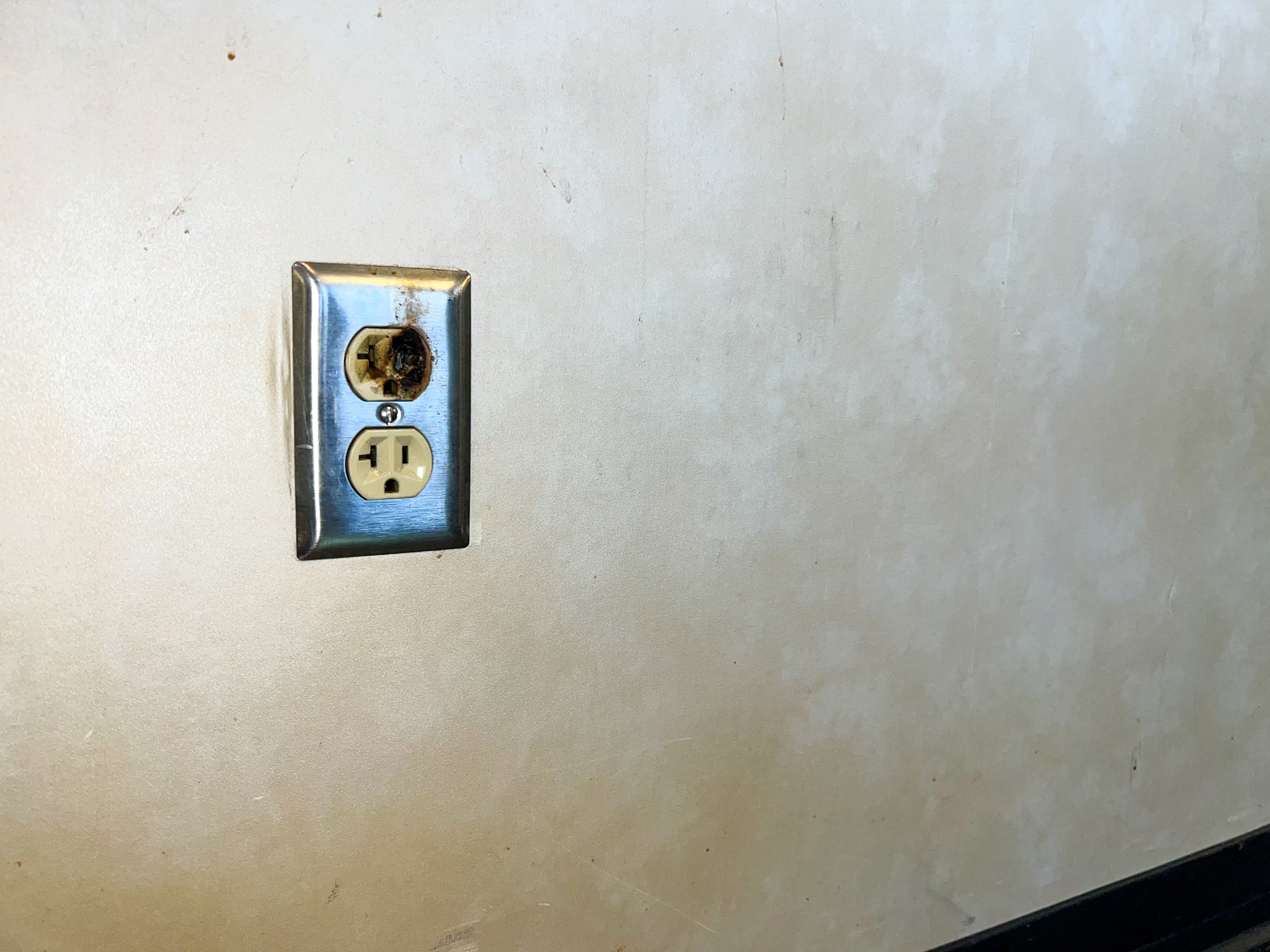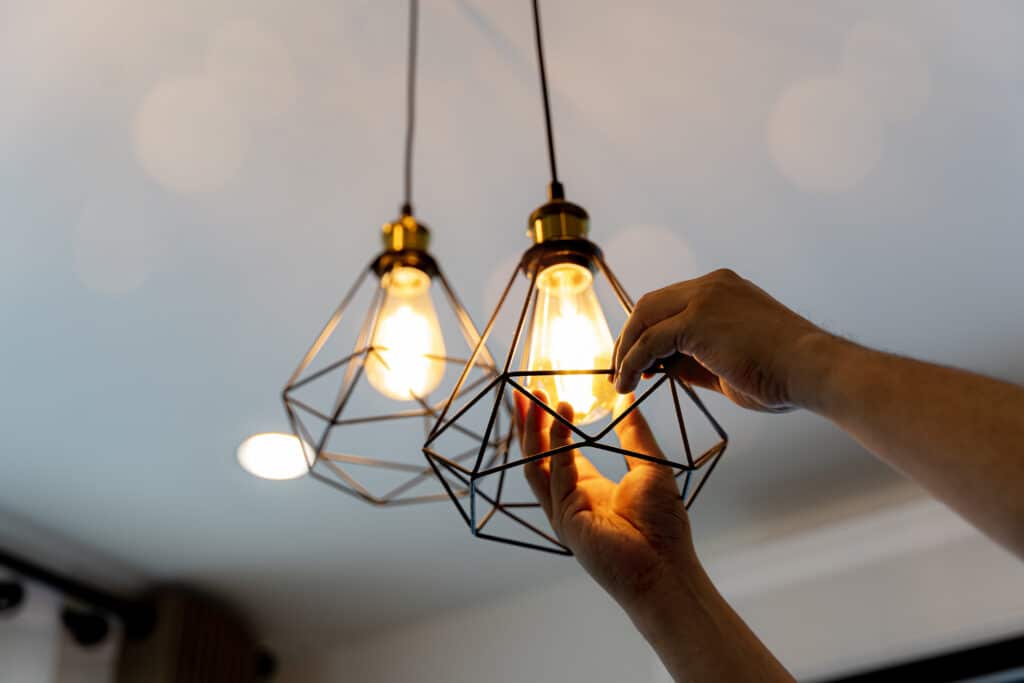Flickering lights can be more than just a minor annoyance; they often signal underlying electrical issues that require prompt attention. Understanding the common causes of flickering lights is essential for maintaining a safe and comfortable home environment. In Newark, DE, where both historic and modern homes abound, addressing these issues promptly is crucial to ensure the safety and reliability of your electrical system.
1. Loose or Faulty Light Bulbs Often Cause Flickering Lights
Loose or defective light bulbs are one of the most frequent causes of flickering lights inside Newark homes. When a bulb is not secured tightly, the electrical contact becomes unstable. That instability results in inconsistent current flow, which causes the bulb to flash or flicker without warning. This is especially common with older incandescent and fluorescent models.
Even minor vibrations from nearby appliances can shift a bulb slightly in its socket. That small movement breaks the electrical connection and creates flickering lights during normal use. Ceiling fans, garage doors, or heavy footsteps often trigger this subtle movement. Eventually, repeated shifting may also wear down the fixture itself.
Sometimes, the bulb is to blame, even if it is brand new. Poorly manufactured or damaged bulbs cause power disruptions inside the filament or circuitry. Replacing the bulb usually solves the problem unless there’s a bigger issue with the socket or wiring. Always double-check bulb compatibility as well.
When flickering lights start, begin by inspecting each bulb closely. A quick adjustment or replacement can often restore full brightness. From there, explore other electrical causes if the issue continues.
2. Dimmer Switch Issues That Often Lead to Flickering Lights
Flickering lights are often caused by incompatible or outdated dimmer switches that struggle to regulate voltage correctly. Traditional dimmers were made for incandescent bulbs and do not always work well with modern LEDs or CFLs. When mismatched, the result is uneven lighting that dims, flashes, or pulses unexpectedly. This issue appears more clearly at low light settings where current levels fluctuate.
Even new dimmers can create problems if they are not properly rated for the type or wattage of your lighting. Using a dimmer outside its capacity causes power drops and flickering lights during regular use. When the wrong dimmer is installed, light output becomes unstable. This can affect mood lighting, task lighting, and even whole-room visibility.
Faulty or aging dimmers may also trigger flickering. Internal wear or loose wiring inside the switch leads to voltage irregularities. If multiple fixtures connected to one switch flicker, that dimmer likely needs replacement. Addressing it early prevents larger electrical problems.
Always choose dimmer switches compatible with your bulb type and wattage. This ensures steady light output and eliminates flickering lights for good. The right dimmer makes all the difference.
3. Voltage Fluctuations and Overloaded Circuits
Flickering lights often occur when large appliances like air conditioners or refrigerators activate and pull a sudden electrical load. That quick demand drop lowers voltage across connected circuits, causing lights to dim or pulse momentarily. If this happens regularly, your system may be operating beyond its safe capacity. These signs point to overloaded circuits or imbalanced electrical distribution.
Many Newark homes experience flickering lights when too many appliances share a single circuit. The increased power demand overwhelms that line, disrupting voltage to lights and outlets nearby. Overloaded circuits heat up quickly, raising the risk of damage or fire. Managing load distribution helps maintain steady, safe power flow.
Voltage fluctuations also happen when wiring can’t handle the energy flow modern appliances require. Older or undersized wires restrict current and cause dimming or flickering lights during operation. Circuit breakers may trip under the pressure, signaling a need for upgrades. This issue is common in older homes with original electrical infrastructure.
Resolving flickering lights caused by voltage drops requires proper circuit assessment. Fixing imbalances and redistributing power ensures smoother performance. Your home works best with a stable, properly managed electrical load.
4. Loose Wiring and Electrical Connections Behind Flickering Lights
Lights that flicker for no clear reason often point to something hidden, unsecured or deteriorated wiring inside your home’s electrical system. These loose connections interrupt the steady flow of electricity, creating short gaps that result in flickering lights. You may notice the problem randomly, but it often gets worse over time. Even a single loose wire can disrupt power across multiple fixtures.
As wires age, they can shift slightly from vibration, heat cycles, or accidental pressure during repairs. Terminals loosen, contact weakens, and suddenly the current is not moving as smoothly as it should. These moments of interrupted flow lead to flickers that become more frequent. If left unresolved, they may evolve into sparks or overheating inside the walls.
This problem tends to show up in older homes or properties that haven’t had recent electrical inspections. Flickering lights that change in intensity or occur across different areas often point to multiple loose connections. Catching the issue early keeps it from spreading further.
Do not overlook flickering lights as a simple inconvenience. They may be the first signal that your home’s wiring needs immediate and professional attention.
5. Utility Service Issues That Trigger Flickering Lights
Sometimes the problem with flickering lights is not inside your home, it starts with the power supply coming from the utility company. External lines, transformers, or neighborhood substations may experience technical faults or weather-related damage. When that happens, homes throughout the area may see lights dim or pulse unexpectedly. These disturbances are especially common during storms or after sudden grid repairs.
If your lights flicker and neighbors report the same issue, it is a sign the problem lies upstream. Tree limbs falling on power lines or fluctuating voltage from a stressed grid can disrupt the flow of electricity. These dips in power affect lighting first, making flickering lights a common early symptom. Even brief utility disruptions can create noticeable changes in home lighting.
Unlike internal wiring problems, utility-related flickering can’t be solved with adjustments inside the house. In these situations, contacting your electric company is the best first step. They have the tools and access to diagnose issues on poles, lines, or transformers.
When flickering lights affect more than just your home, do not wait. Report the problem and ensure your area receives the maintenance or repair it needs.

Signs Flickering Lights Are Linked to Wiring Damage
Flickering lights do not always mean a bulb is loose, they are often early signs of wiring problems that need urgent attention. Electrical damage behind walls can grow dangerous quickly. Here are six signs your flickering lights could be connected to damaged wiring:
- Burning smells from outlets or switches
A sharp, burning odor usually signals overheating wires that may be sparking behind the wall. - Black or brown discoloration on faceplates
Scorch marks around outlets show past overheating, often caused by frayed or loose electrical wires. - Flickers when using appliances
If lights dim when appliances start, wiring may be undersized or unable to handle modern electrical loads. - Buzzing or crackling from switches
Unusual sounds when flipping a switch point to broken or loosely connected wires within the wall. - Circuit breakers that trip often
Breakers that constantly shut off may be reacting to shorts caused by damaged or exposed wires. - Lights flicker across several rooms
Widespread flickering lights suggest major wiring issues near your breaker box or main service panel.
Recognizing these signs early helps prevent electrical hazards and ensures your home remains safe.
What Frequent Bulb Replacements Say About Flickering Lights
Replacing light bulbs more often than expected could point to a larger electrical issue rather than faulty products. If bulbs burn out quickly, flickering lights may be stressing them through inconsistent power delivery. This kind of strain shortens the life of LED, incandescent, and CFL bulbs. When the problem repeats in the same fixture, deeper issues are often to blame.
Flickering lights caused by voltage fluctuations or loose connections increase wear on the bulb’s internal components. The constant on-and-off effect generates heat and weakens the filament or circuitry over time. Eventually, this leads to early bulb failure. Simply replacing the bulb won’t stop the cycle if the root cause remains untouched.
You might also notice bulbs that work fine in one fixture but fail in another. That difference suggests the issue lies within the wiring or the socket itself. Worn-out or improperly installed fixtures often disrupt electrical flow. Overloaded circuits may also contribute.
Frequent bulb changes are more than frustrating, they are a warning sign. Flickering lights tell you something’s wrong behind the scenes. Addressing the cause helps restore both brightness and peace of mind.
Why Flickering Lights Should Never Be Ignored in New Homes
Even brand-new homes in Newark, DE are not immune to electrical issues. Flickering lights in modern builds often trace back to rushed or careless installations. Loose terminals, weak breaker connections, or mismatched components create instant problems after move-in. While everything appears new, hidden defects can still cause serious safety risks.
Contractors sometimes overlook small wiring errors during final inspections. These errors may not trigger outages but still lead to flickering lights. You might notice inconsistent brightness, especially with high-efficiency LED fixtures. Minor flaws at the start can become major failures without prompt attention.
New homes also come with high-tech appliances and smart systems that increase electrical load. If your panels or circuits are not balanced properly, flickering lights can occur even with basic usage. The issue is not always visible but still poses a threat. Checking panel load and circuit design ensures lasting stability.
Never assume flickering lights are harmless just because the home is new. Every flicker points to something that needs review. Early action prevents damage and keeps systems running safely. Peace of mind starts with recognizing early electrical signals.
How Appliances Trigger Flickering Lights Without Warning
Large appliances can cause flickering lights without showing obvious signs of malfunction. Air conditioners, refrigerators, and microwaves pull heavy current when starting up. That sudden demand lowers voltage briefly, making nearby lights dim or flicker. If it happens often, your system may be struggling to handle the load.
Flickering that aligns with appliance use points to potential circuit overload. Many homes have older panels not built for today’s high-energy devices. Running multiple appliances on the same circuit intensifies the problem. Eventually, breakers may trip or wires may overheat.
If lights flicker in other rooms while using appliances, the issue could be more widespread. This usually means your electrical distribution is not balanced properly. Some circuits might carry too much, while others remain underused. That imbalance places stress on your panel and shortens its lifespan.
Flickering lights triggered by everyday appliance use are not something to ignore. Small symptoms often reveal bigger system flaws. Fixing these problems early avoids costly future repairs. Your home should handle modern living without constant electrical disruptions.
The Role of Breaker Panels in Flickering Lights
Your breaker panel plays a central role in controlling power throughout the home. If it malfunctions, flickering lights often follow quickly. Older panels, especially those with outdated designs, struggle to keep up with current electrical needs. Loose breakers or corroded components make the problem worse.
Each time a breaker connects unevenly, it interrupts power flow and causes lights to flicker. Over time, that strain damages not only the breaker but connected circuits as well. Burned or humming breakers are clear signs of internal issues. Flickering lights are usually the first warning sign of more serious trouble.
If flickers happen across multiple rooms or floors, the issue likely starts at the panel. Undersized panels can’t distribute electricity evenly, leading to noticeable performance dips. When circuits trip often or stay warm, it is time for a full evaluation. Keeping panels updated protects every outlet, light, and device in the home.
Never ignore flickering lights near the main panel. What seems small can grow dangerous quickly. Secure, well-maintained breakers keep your home’s electrical system running safely and smoothly every day.

What Temporary Flickering Lights May Reveal About Long-Term Problems
Some flickering lights stop after a few seconds, leading many to ignore the issue. But even brief flickers can signal hidden trouble. Momentary voltage drops often come from poor grounding or intermittent connections. Without inspection, those minor disturbances can grow into larger electrical failures over time.
Lights that flicker after storms or power outages suggest damage in external or internal wiring. While the power may return quickly, electrical components may have suffered unseen strain. These disturbances can loosen connections or overheat sensitive parts. Catching problems early prevents future surprises or equipment loss.
If flickering lights appear only during certain times of day, the pattern matters. Increased neighborhood power demand in the evening can expose weaknesses in your home’s system. This includes shared transformers or feeder lines that can’t keep up. Your home’s circuits may be reacting to external voltage dips.
Do not dismiss flickering lights that disappear quickly. Every instance adds wear and stress to your electrical setup. Consistent performance should never include random flashes. Long-term safety starts with recognizing even short-term signs of potential electrical failure.
Taking the Right Action When Flickering Lights Appear
Flickering lights may seem minor at first, but they often signal deeper issues that require immediate attention. Ignoring them can allow small electrical problems to grow into serious hazards. Once you notice flickering, take note of when and where it occurs. Tracking the pattern helps determine if the cause is isolated or more widespread.
Start by checking for loose bulbs or incompatible dimmers in the affected areas. If everything appears secure but the flickering lights persist, the issue likely involves wiring or circuit load. Shut off affected lights and avoid using nearby outlets until the problem is identified. That step helps prevent overheating or damage to connected devices.
If the flickering happens across multiple rooms, take it seriously. This often points to problems with your panel, overloaded circuits, or aging wiring. Avoid resetting breakers repeatedly, this can mask serious electrical faults.
Always act quickly when you notice flickering lights, especially if the issue spreads or worsens. Prompt attention protects your home from fire risks, appliance damage, and power failure. Safe lighting starts with smart decisions and timely electrical care.
Creating a Safer Home by Addressing Flickering Lights Early
Flickering lights are more than a distraction, they are an early warning that something in your electrical system needs professional attention. Ignoring these signals can lead to bigger issues, including equipment failure or fire hazards. Taking action early helps maintain a safe and reliable home. Do not wait until the lights go out to respond to signs of trouble.
Addressing flickering lights promptly reduces long-term risks and avoids costly repairs. Whether the issue stems from outdated wiring or overloaded circuits, resolving it early protects your investment. A stable electrical system also improves daily comfort and reduces energy waste. Mister Sparky of New Castle County can help ensure everything runs safely and efficiently.
Homes in Newark, DE, especially older ones, benefit from regular electrical inspections. These evaluations catch worn-out components, loose connections, and potential panel issues before they cause widespread disruptions. Preventive care now prevents emergencies later. Trust local expertise for lasting peace of mind.
If flickering lights have become part of your daily routine, it is time to take action. Call Mister Sparky of New Castle County to keep your home secure, bright, and problem-free year-round.
FAQS
-
Are flickering lights always a sign of danger?
Not always, but they should never be ignored. Flickering lights often indicate underlying electrical problems that could become dangerous over time.
-
Can a single faulty bulb cause flickering lights throughout my home?
No, a single bulb usually only affects one fixture. If lights flicker in multiple areas, the issue likely involves circuits or wiring.
-
Should I worry if my lights flicker only during storms?
Yes, weather-related flickering lights could mean your system is vulnerable to external voltage changes. An inspection ensures proper grounding and protection.
-
Why do new bulbs still flicker in certain fixtures?
Some dimmer switches or sockets may not be compatible with modern bulbs, causing flickering lights even with brand-new lighting.
-
Can Mister Sparky of New Castle County fix flickering lights in older homes?
Absolutely. We specialize in identifying outdated components and resolving flickering lights in both older and newer Newark, DE homes.










